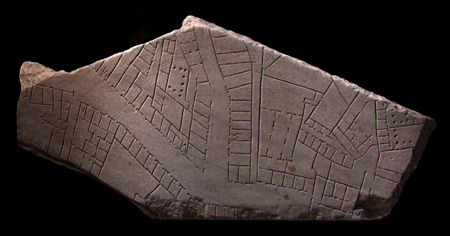








|
|
The Scotsman
Innovative software offers clues to Rome map puzzle
May 19th, 2004
"They've advanced farther and faster in the last months than we have in centuries," said Roman archaeologist Margaret Laird, a visiting lecturer at the University of Chicago. "These new matches are going to change a lot of what we know about the city of Rome."
The undertaking is a five-year study conducted by Marc Levoy, an associate professor of computer science and electrical engineering at Stanford, to be completed by the summer. The findings and interactive 3-D models of the fragments are online, allowing scholars as well as elementary-school students unprecedented access to the monument.
It's the first time anyone has applied technology to piece together the ancient puzzle. Short of a 1961 book that's now out of print, the project's Web site is the only place where archaeologists will be able to examine each fragment of the map, known as the Forma Urbis Romae.
Levoy thinks the advance may shepherd a "revolution in computational humanities," where technology and the arts intersect.
"There is a trend toward putting knowledge online, where it can be searched by anyone," said Levoy. "Google is the encyclopedia of tomorrow. A kid working on his sixth-grade history report of Roman aqueducts now has access to information you'd find in a graduate library."
The project started in 1999, when Levoy and a group of students went to Italy to scan and build a 3-D interactive model of Michelangelo's "David." As a side project, they went to Rome and scanned the fragments of the ancient map, working around the clock and sleeping in shifts to meet a deadline.
The third-century map itself is a feat of cartography. It detailed nearly every architectural feature of the city, from large monuments like the Colosseum to shops, apartments and even staircases. The completed map, made up of several marble slabs, measured 60 feet by 43 feet and hung in one of the grandest monuments of the ancient city, the Templum Pacis. Today, only about 15 percent of the map survives - but it includes core parts of the city.
For centuries, scholars have visually matched up the heavy pieces of marble, some weighing several hundred pounds. In modern times, one match has been found every few years - a cause for huge celebration in the academic world.
The software program finds an average of one match a month.

One of the fragments
Graduate student David Koller, who wrote the program, likens it to one that tries to piece a broken vase back together. The first piece of software he wrote tried to find matches by looking at the sides of each map fragment. Alone, that didn't work because many of the sides have eroded over time.
Then he wrote other algorithms that took into account factors such as the thickness of the fragments and the distinct veins running through the marble. The program also takes, for example, a column apparent in one fragment, notes where and in which direction it leaves the piece and then searches other fragments for complementary features.
"The computer is using the same cognitive process that a human uses to put a jigsaw puzzle back again," said Koller. "It just does it a lot faster and with more pieces."
In June, Koller was convinced he found a match. He and a small group went back to Italy and opened up the locked crates where the fragments are kept. They put the two pieces together.
"There was no question it fit," said Koller. "You can feel it lock into place in your hand."
The pieces depict the Circus Maximus, the stadium where chariot races took place. The lines that connect the fragments make up the road where Romans would march in ceremony after a triumph.
Since then, Koller has found a dozen other matches that he thinks have a 98 percent probability of fitting and several dozen others that are possible matches. The team is eager to improve its odds by applying another set of algorithms used in the Human Genome Project, to bridge large gaps between markers on DNA sequences. These new algorithms would put together pieces that don't perfectly fit now because of gaps caused by erosion.
At a conference about the map last month, the findings were presented amid gasps and delighted laughter.
"We're not going to solve the whole map," said Levoy, who is now looking into underwater imaging. "It's on the Web. It's now available for other scholars around the world to try to solve the map."
More on this project:
The project can be seen online at formaurbis.stanford.edu

|
|
|